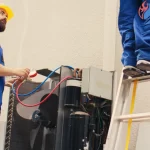Parts of air compressor and its function
An air compressor is a mechanical device that converts power into potential energy stored in pressurized air. It works by taking in ambient air and compressing it to a higher pressure, which can be used for a variety of applications, including powering pneumatic tools, inflating tires, or supplying air to industrial machinery. Air compressors can be found in a variety of settings, including factories, workshops, and garages.
The design of an air compressor can vary widely depending on the intended application and the specific requirements of the user. However, all air compressors have a number of essential components that work together to produce compressed air. In this article, we will explore the key parts of an air compressor and their functions.
Air Intake Filter
The air intake filter is the first line of defense for an air compressor. Its job is to prevent dirt, dust, and other contaminants from entering the compressor and damaging its internal components. The air intake filter is typically made of a pleated paper or foam material and is located on the outside of the compressor. Over time, the filter will become clogged with dirt and debris, reducing the airflow into the compressor and decreasing its efficiency. It is important to clean or replace the air intake filter regularly to ensure that the compressor continues to function properly.
Compressor Pump
The compressor pump is the heart of the air compressor. Its job is to compress the air that is drawn in through the air intake filter and store it in a compressed air tank or reservoir. The compressor pump is typically driven by an electric motor or gasoline engine and can be designed in a variety of configurations, including reciprocating, rotary screw, and centrifugal.
Reciprocating compressors use pistons and cylinders to compress the air. They are typically less expensive and more compact than other types of compressors, making them a popular choice for home and small business use. Rotary screw compressors use a pair of interlocking helical screws to compress the air. They are more expensive than reciprocating compressors but are more efficient and have a longer lifespan. Centrifugal compressors use a high-speed impeller to compress the air and are typically used for large industrial applications.
Pressure Switch
The pressure switch is a safety device that controls the operation of the air compressor. Its job is to monitor the pressure in the compressed air tank or reservoir and turn the compressor on or off as needed. When the pressure in the tank drops below a certain level, the pressure switch will turn the compressor on and start the process of compressing more air. When the pressure in the tank reaches a certain level, the pressure switch will turn the compressor off to prevent over-pressurization.
Compressed Air Tank or Reservoir
The compressed air tank or reservoir is where the compressed air is stored after it has been produced by the compressor pump. The tank is typically made of steel and is designed to withstand high pressures. It is equipped with safety valves that release excess pressure to prevent the tank from rupturing. The size of the tank can vary depending on the intended use of the compressor. A larger tank will allow for longer periods of use without the need for the compressor to turn on and off.
Regulator
The regulator is a device that controls the pressure of the compressed air that is released from the tank. Its job is to reduce the pressure to a level that is safe for the intended application. For example, a pneumatic tool may require a pressure of 90 psi, while a tire may only require a pressure of 30 psi. The regulator can be adjusted to achieve the desired pressure level. Some regulators also include a gauge that displays the current pressure level.
Safety Valve
The safety valve is a critical safety device that is designed to prevent the compressed air tank or reservoir from over-pressurizing and rupturing. The safety valve is typically located on the tank and is set to release at a predetermined pressure level. If the pressure in the tank exceeds this level, the safety valve will open and release the excess pressure. This prevents the tank from becoming a potential hazard to the user and those in the surrounding area
Drain Valve
The drain valve is a small device that is located at the bottom of the compressed air tank or reservoir. Its job is to allow water and other contaminants that have accumulated in the tank to be drained out. Over time, water can build up in the tank as a result of the compression process. This water can cause corrosion and other damage to the tank and other components of the air compressor. The drain valve should be opened periodically to remove any water or other contaminants that have accumulated in the tank.
Oil Lubrication System
The compressor pump in many air compressors requires lubrication to operate properly. The oil lubrication system is responsible for providing this lubrication. It typically consists of an oil reservoir, an oil pump, and oil lines that distribute the oil to the various components of the compressor pump. The oil lubrication system should be checked regularly to ensure that the oil level is adequate and that the oil is clean and free of contaminants.
Motor or Engine
The motor or engine is the power source for the air compressor. The motor is typically an electric motor, while the engine is usually a gasoline or diesel engine. The motor or engine provides the power that drives the compressor pump and other components of the air compressor.
Control Panel
The control panel is the interface between the user and the air compressor. It typically includes a power switch, a pressure gauge, and various controls for adjusting the pressure and other settings. Some air compressors may also include additional features, such as a timer or automatic shut-off.
conclusion
In conclusion, understanding the key parts and their functions is essential for the proper maintenance and operation of an air compressor. As a leading provider of air conditioning services, Al Hadi AC Repair & Maintenance Services recognizes the importance of well-maintained air compressors for the smooth functioning of various HVAC systems. Our team of experienced professionals is well-versed in the various components of air compressors and can provide expert repair and maintenance services to ensure the long-term reliability and efficiency of your compressor. By trusting Al Hadi AC Repair & Maintenance Services, you can be assured that your air compressor is in good hands, and our team will work diligently to ensure that all components are properly maintained and serviced, leading to a trouble-free and efficient operation of your HVAC systems.




